Reviews: Revenue-Generating Storage Appliances From Barracuda, ION
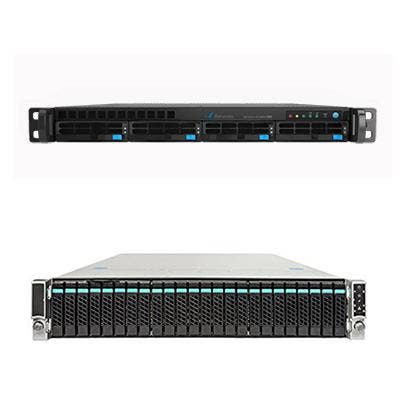
Storage Appliances
As the universal need for increasing amounts of digital storage continues to expand, innovative manufacturers continue to find ways to exploit the individual niches that inevitably emerge. Often such solutions manifest themselves as dedicated hardware appliances, cloud-based systems or a combination of the two.
The CRN Test Center has identified two such specialty products. As with network-attached storage covered earlier this week, appliances can provide MSPs and solution providers with revenue from the initial sale, installation and setup and ongoing service revenue from the creation and maintenance of user accounts and groups; ongoing moves, adds, changes and other administrative tasks; upgrades to drive capacities, memory and services; and from sales of accessories and the addition of cloud-based services. As Storage Week 2015 continues, here's a look at the Message Archiver from Barracuda Networks and the SpeedServer SR71 from ION Computer Systems.
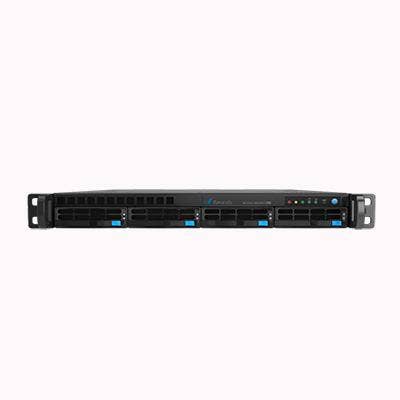
Barracuda Message Archiver
With a major embedded-software update in October, Barracuda gave the Message Archiver a face-lift. The network security appliance maker last fall released version 4.0 of the firmware to integrate the email archiving appliance with Barracuda's existing like-featured cloud system and enhance it with features such as mirroring and data rotation, federated search across multiple cloud and on-premise archives, and the addition of search, export and forwarding capabilities. The browser-based administrator interface also got a major UI overhaul with massive improvements to its look and feel.
Available in seven models in 1U to 4U and for up to 2,000 users, the Message Archiver 1U appliance is intended to allow companies to easily offload as much as 8 TB of mail messages and attachments from mainline servers to a RAID-protected appliance while retaining the ability to search and retrieve them, and to set retention policies based on compliance laws or company preferences. It's also available as a virtual appliance and a cloud service with federated search across any combination of the three. Most of the models include error correcting memory, dual Gigabit Ethernet with failover and a customizable branding option.
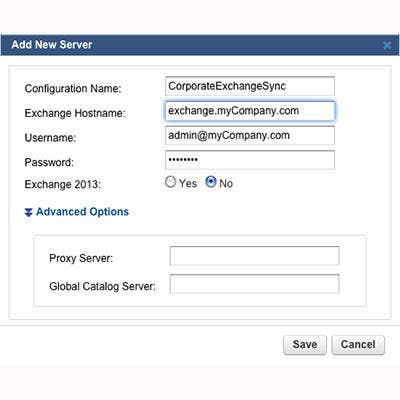
Barracuda Setup
As is typical of Barracuda systems, setup and configuration documentation for the Message Archiver is top-notch. There are even specific docs for Google Apps setup. Configuring the Barracuda Archiver was straightforward and well documented. After providing power, keyboard, mouse and monitor, IP addresses are input using a simple text interface. After opening a few specific ports on the corporate firewall, the remainder of the setup is done through a browser. The 350 presents a simple tab-based interface for registering the device for entering the default domain name(s) of the email system(s) to be archived. Finally, the setup process recommends a password change and a check for updates to the firmware. Setup time to this point was about 30 minutes including a firmware update.
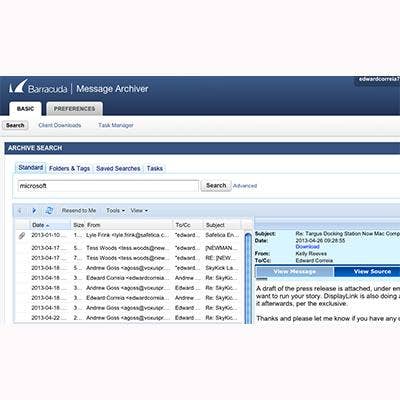
Barracuda Performance
To test the Message Archiver, we connected it to a personal Gmail account and watched it do its thing. There's support for Active Directory and LDAP for large organizations, but manual data entry was fine for our purposes. Making the connection was simply a matter of confirming which protocol was in use (POP or IMAP), entering the appropriate server name, email address, password plus security and port settings. Within a few moments, email messages from the account were appearing in the archive tab. It's just as easy to connect with Exchange and GroupWise servers. It also supports Exchange Stubbing -- the storage of email attachments only -- which reduces the storage needs of the mail server.
We tested the user experience by setting up a sample account with access to our test-archived email. The user logs in the same way as an administrator but with just a few tabs, including those for Search, Download and Password. Searches can be by plain-text and by folder and tag, and can be saved. Search results appear instantly. If configured by the admin, the Downloads tab could contain add-ins for Outlook and Lotus Notes, as well as stand-alone search apps for Android, iOS, Mac OS X and Windows. The Message Archiver 350 consumed about 33 watts during most activities and occasionally spiked at around 54 watts.
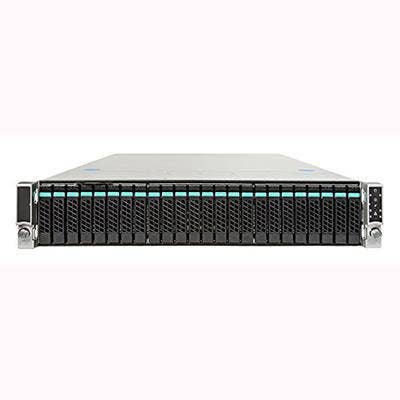
ION Computer Systems
ION Computer Systems, a Long Island-based server and storage-appliance builder, is dedicated to building the fastest storage systems money can buy. And in large part it has succeeded. Its latest-generation of all-SSD RAID server, the SpeedServer SR-71mach5, routinely delivers data transfer rates that approach the limits of a 10-Gbps network itself. The CRN Test Center visited ION's headquarters in Hauppauge, N.Y., to explore the SpeedServer's latest performance improvements and take some measurements of our own. Here's what we found.
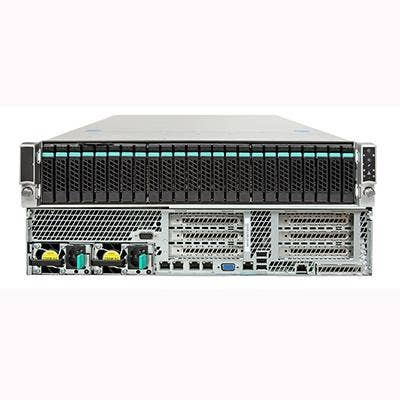
SpeedServer Config
The SR-71 is still built around a motherboard from Intel, but this time it's from the Wildcat Pass, a series of two-socket mainboards launched last year for Intel Xeon E5-2600 v3 processors. This allows the SR-71 to scale to as many as 18 cores per CPU, up from 12. It also boosts memory speed to 2,133MHz from 1,600MHz and doubles RAM channels to four and capacity to 768 GB in 24 DIMM slots. Expansion slots increase from six to eight with support for as many as 14 10-Gbps Ethernet ports or with a mixture of Fibre Channel ports. But according to ION founder Keith Josephson, core count is not the most important spec for systems like this. "On a storage system, a higher clock speed seems to help performance more than having more cores, depending on what you're doing." The tested system had two Intel Xeon E5-2690 v3 12-core processors running at 2.6GHz.
As for storage, the tested system had three RAID 5 arrays, each with eight Intel DC-S3610 800-GB data center drives controlled by an Intel-branded LSI MegaRAID SAS3 (12-GBps) controller. Even though the drives themselves provide a 6-Gbps interface, Josephson says that having a 12-Gbps SAS3 controller is still an advantage. "It can do more things faster, and having the SSDs as the bottleneck is not necessarily a bad thing." The SR-71 now has a maximum storage capacity of around 25 TB, up from 13 TB of the prior model.
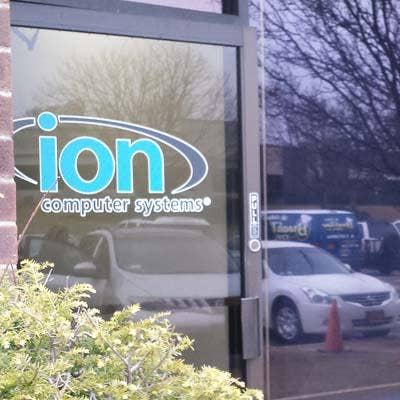
ION Performance
Like the Test Center, Josephson uses IOmeter to benchmark the data transfer rates and transaction processing performance of all the company's new systems. To fully tax the SpeedServer and the 10-Gbps network to which they all were attached, Josephson combined simulated workstations with physical ones. He set up five dual-Xeon machines, each with two 10-Gbps Ethernet NICs. On the server were four 1-TB shared partitions against which the workstations would run their workloads.
The fastest sustained throughput we observed was 9.5 GBps, with random reads of 32K blocks. When the block size was increased to 64K, the rate dropped to 1.475 GBps. And with 4K blocks, the server sustained a rate of 3.0 GBps and more than 1 million IOps. During this last test, we observed an average latency of about 1.1ms. "The best-case scenario on most off-the-shelf systems with a couple of disks is at least 2ms latency or more," said Josephson, for comparison. When running IOmeter's simulated Web server test, the SR-71 sustained about 8 GBps, and a simulated file server delivered 3.1 GBps. This file server simulator combines a range of block sizes between 512 and 64K bytes with an 80/20 read/write split in 100 random order. In this test, the server sustained 287 IOps.
At the time of our visit, ION was in the process of configuring a small army of SpeedServers for an MSP that provides local computing services for airlines and the Federal Aviation Administration. Josephson recalled a recent visit to the customer's facility, describing a computer display of a map of the U.S. covered by tiny colored specs. "When they zoomed in, you realized that each spec represented an airplane flying over the U.S. at that moment," he said. "Zoom in a little more and you can see each plane's flight number, course settings and altitude." The customer's software also logs all flights and provides reporting. "They're a careful customer," he said. "They use a separate system for development. Another for piloting their projects and a third for production. They do things exactly right, and we like that."